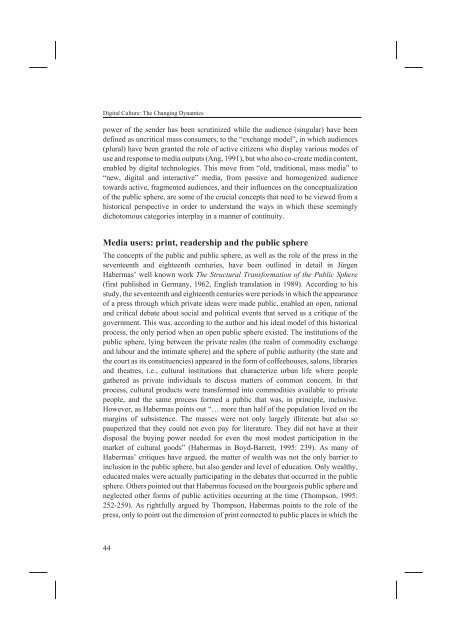D:\Documents and Settings\Ana\My Documents\Biserka-knjiga ...
D:\Documents and Settings\Ana\My Documents\Biserka-knjiga ...
D:\Documents and Settings\Ana\My Documents\Biserka-knjiga ...
Create successful ePaper yourself
Turn your PDF publications into a flip-book with our unique Google optimized e-Paper software.
Digital Culture: The Changing Dynamics<br />
power of the sender has been scrutinized while the audience (singular) have been<br />
defined as uncritical mass consumers, to the “exchange model”, in which audiences<br />
(plural) have been granted the role of active citizens who display various modes of<br />
use <strong>and</strong> response to media outputs (Ang, 1991), but who also co-create media content,<br />
enabled by digital technologies. This move from “old, traditional, mass media” to<br />
“new, digital <strong>and</strong> interactive” media, from passive <strong>and</strong> homogenized audience<br />
towards active, fragmented audiences, <strong>and</strong> their influences on the conceptualization<br />
of the public sphere, are some of the crucial concepts that need to be viewed from a<br />
historical perspective in order to underst<strong>and</strong> the ways in which these seemingly<br />
dichotomous categories interplay in a manner of continuity.<br />
Media users: print, readership <strong>and</strong> the public sphere<br />
The concepts of the public <strong>and</strong> public sphere, as well as the role of the press in the<br />
seventeenth <strong>and</strong> eighteenth centuries, have been outlined in detail in Jürgen<br />
Habermas’ well known work The Structural Transformation of the Public Sphere<br />
(first published in Germany, 1962, English translation in 1989). According to his<br />
study, the seventeenth <strong>and</strong> eighteenth centuries were periods in which the appearance<br />
of a press through which private ideas were made public, enabled an open, rational<br />
<strong>and</strong> critical debate about social <strong>and</strong> political events that served as a critique of the<br />
government. This was, according to the author <strong>and</strong> his ideal model of this historical<br />
process, the only period when an open public sphere existed. The institutions of the<br />
public sphere, lying between the private realm (the realm of commodity exchange<br />
<strong>and</strong> labour <strong>and</strong> the intimate sphere) <strong>and</strong> the sphere of public authority (the state <strong>and</strong><br />
the court as its constituencies) appeared in the form of coffeehouses, salons, libraries<br />
<strong>and</strong> theatres, i.e., cultural institutions that characterize urban life where people<br />
gathered as private individuals to discuss matters of common concern. In that<br />
process, cultural products were transformed into commodities available to private<br />
people, <strong>and</strong> the same process formed a public that was, in principle, inclusive.<br />
However, as Habermas points out “… more than half of the population lived on the<br />
margins of subsistence. The masses were not only largely illiterate but also so<br />
pauperized that they could not even pay for literature. They did not have at their<br />
disposal the buying power needed for even the most modest participation in the<br />
market of cultural goods” (Habermas in Boyd-Barrett, 1995: 239). As many of<br />
Habermas’ critiques have argued, the matter of wealth was not the only barrier to<br />
inclusion in the public sphere, but also gender <strong>and</strong> level of education. Only wealthy,<br />
educated males were actually participating in the debates that occurred in the public<br />
sphere. Others pointed out that Habermas focused on the bourgeois public sphere <strong>and</strong><br />
neglected other forms of public activities occurring at the time (Thompson, 1995:<br />
252-259). As rightfully argued by Thompson, Habermas points to the role of the<br />
press, only to point out the dimension of print connected to public places in which the<br />
44



